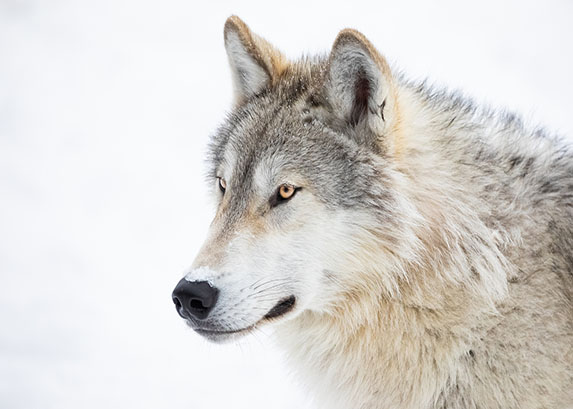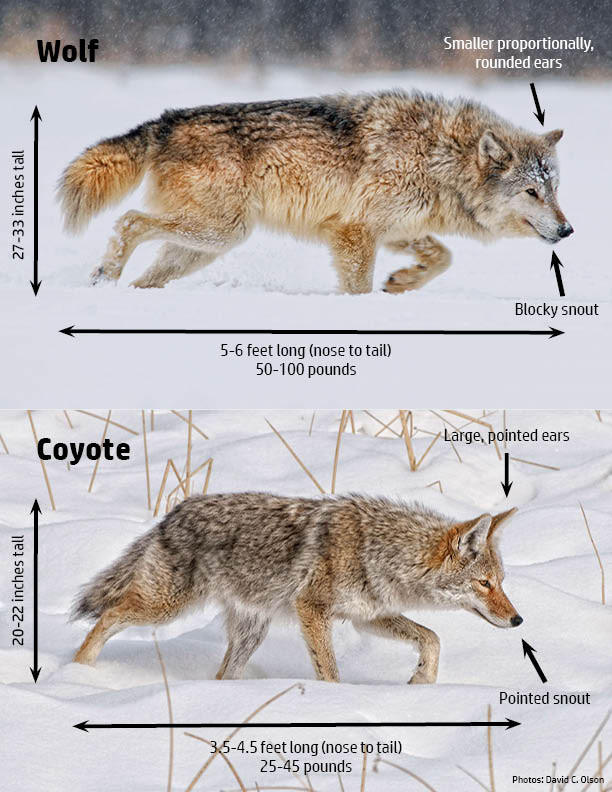Wolf hunting and trapping
Following a federal court ruling on Feb. 10, 2022, gray wolves are listed as an endangered species in the lower 48 states (excluding the northern Rocky Mountains region) and are federally protected. Harvest and lethal depredation control are prohibited.
Wisconsin's wolf population remains healthy and secure. The department will continue its robust wolf population monitoring program and partnering with USDA-Wildlife Services to address wolf conflicts in Wisconsin.
If you suspect wolves in the depredation of livestock, pets, or hunting dogs, or if wolves exhibit threatening or dangerous behavior, contact USDA-Wildlife Services staff immediately. If in northern Wisconsin, call 1-800-228-1368 or 715-369-5221; in southern Wisconsin, call 1-800-433-0663 or 920-324-4514. While gray wolves are listed as a federally endangered species, it remains unlawful to shoot a wolf unless there is an immediate threat to human safety.
Season Dates, Regulations And Hours
Following a federal court ruling on Feb. 10, 2022, gray wolves are listed as an endangered species in the lower 48 states (excluding the northern Rocky Mountains region) and are federally protected. Harvest and lethal depredation control are prohibited.
Current state law (s. 29.185, Wis. Stats.) directs the department to allow the hunting and trapping of wolves when wolves are not listed on the federal or state list of threatened and endangered species. Among many aspects, this law identifies that a single annual open season for both hunting and trapping wolves shall begin on the first Saturday in November of each year and end on the last day of February of the following year. Management zones may be closed before this date if the department determines a closure is necessary to effectively manage the wolf population, such as if harvest quotas are reached before the end of the season.
Purchase A Hunting License
Because there is no wolf harvest season at this time, no applications will be accepted, and preference points for hunters cannot be purchased.
In years with a wolf harvest season, wolf harvest licenses are issued through an application and two-stage drawing process, as identified in state statute. The initial drawing for 50% of the available licenses is issued through a random lottery in which all applicants are entered. The remaining 50% of the available licenses are issued based on the cumulative preference points of applicants, which provides unsuccessful applicants from prior years a greater chance to obtain a license. Residency status does not influence the drawing. Each awarded license, once purchased, allows the licensed hunter or trapper to harvest one wolf by any legal method.
February 2021 Wolf Season Drawing Summary
Check Your Preference Points
Hunters can determine the number of preference points they have accumulated in three ways. To find out how many points you have accumulated:
- contact the DNR Call Center at 1-888-936-7463;
- visit the online licensing center or
- contact your local DNR Service Center.
Note: A person authorized to purchase a license for a permit or harvest authorization issued under a cumulative preference drawing may transfer their awarded permit or harvest authorization to another who meets the required qualifications on the Authorization Transfer webpage.
Hunting Programs
Trapper Education
Basic trapper education has been a mandatory requirement for anyone wanting to trap in Wisconsin since 1992 (with some exemptions for landowners, farmers and those grandfathered in). Trapper education is a collaborative effort between the Wisconsin Trappers Association (WTA) and the department and is serviced through the Wisconsin Cooperative Trapper Education Program (WCTEP). This program provides essential information on basic biology, trapper responsibility, rules and regulations, traps and trap systems and trapper ethics to thousands of interested participants annually. Through this cooperative program, advanced wolf trapper education workshops have also been offered in some years at facilities across the state. Like the basic trapper education program, advanced wolf workshops focus on traps, trap systems, trapper responsibility, rules and regulations. Throughout the program, there is an emphasis on respect for the animals and other citizens.
Please see the Trapper Education Course Information webpage to learn more about Trapper Education opportunities.
Where To Hunt
Public Access Lands
- The Public Access Lands viewer is an interactive web mapping application that can be used to locate, access and view information about open public lands.
- The Voluntary Public Access and Habitat Incentive Program (VPA-HIP) provides financial incentives to private landowners who open their property to public hunting, fishing, trapping and wildlife observation. To find a list of VPA-HIP properties, please see the VPA-HIP Program page.
- Through the Managed Forest Law (MFL) and Forest Crop Law (FCL) programs, some private forest lands are open to the public for recreational purposes. This web mapping tool can help you find which lands are now available.
Hunting Safety Tips
Hunter Safety Education
Anyone born on or after Jan. 1, 1973, must complete a hunter education course and have a hunter education safety certificate on file to purchase any hunting license in Wisconsin. However, suppose they will be hunting under the hunting mentorship program, or they have successfully completed and have proof of completing basic training in the U.S. Armed Forces, Reserves or National Guard. In that case, they do not need a hunter education safety certificate to purchase a hunting license. To view available courses, visit the Safety Education page.
Please see the Outdoor Skills page for additional safety resources and information.
Follow the four rules of basic firearm safety – TAB-K.
- T = Treat every firearm as if it is loaded. Never assume a gun is unloaded, and never treat it that way, even if you watch as it is unloaded. Make it a habit to treat guns like they are always loaded.
- A = Always point the muzzle in a safe direction. About one-third of all hunting incidents are self-inflicted injuries. That means the muzzle was pointed at some part of the hunterhunter's. A safe approach is where the bullet will travel and harm no one in the event of an unwanted discharge. There are no accidental discharges with firearms, only unwanted discharges.
- B = Be sure of your target and what it is. Positive target identification is a must. To shoot at something you only think is a legal target is gambling. In the case of human injury, that means gambling on human life. You must be specific and correct in judgment before deciding to shoot. Otherwise, it's rit'sess behavior. In addition to identifying the target, a hunter must know that a safe backstop for their bullet is present in every shooting situation. We don't don't hit our target; in some cases, the bullet passes through the target. A safe backstop guarantees that no one will get hurt.
- K = Keep your finger outside the trigger guard until ready to shoot. If a hunter stumbles with a firearm in one hand and nothing in the other, whatever that person does with their free hand will automatically happen with the hand holding the gun. If a finger is inside the trigger guard, that hand will likely close around the gun's grip and on the trigger, causing an unwanted discharge.
Hunter Resources
Wolf Identification
While gray wolves and coyotes may look alike at first glance, hunters and trappers can look for several traits to identify their target species:
- Ears: Wolves' are smaller in proportion to their heads than those of coyotes. Wolves' are also more rounded than coyote ears.
- Snout: Wolves have a blocky snout, while coyotes have a pointed snout.
- Body Length: Nose to tail, mature wolves measure approximately 5-6 feet in length, while mature coyotes measure 3.5-4.5 feet in length.
- Weight: Wolves weigh significantly more than coyotes. A grown wolf will weigh between 50-100 pounds. A grown coyote will weigh between 25-45 pounds.
Best Management Practices for Trapping
A core component of the wolf trapper education curriculum is focused on the Best Management Practices for Trapping. Best Management Practices (BMPs) are carefully researched educational guides to address animal welfare and increase trappers' efficiency and selectivity (AFWA 2019). First initiated by the Association of Fish and Wildlife Agencies in 1997, with support from all fifty states, BMPs for trapping are intended to inform people about traps and trapping systems considered to be state-of-the-art in animal welfare and efficiency. Development of BMPs has been ongoing with a strong focus on identifying practical traps and trapping techniques that continue to improve efficiency, selectivity and the welfare of trapped animals. This program provides specifications for traps that meet or exceed all five criteria of efficiency, selectivity, safety, practicality and animal welfare. The BMP program provides wildlife management professionals and the public with the data necessary to ensure appropriate animal welfare in regulated trapping programs. It also promotes regulated trapping as a modern-day wildlife management tool and instills public confidence and support by sharing science-based information. The wolf trapping BMP, recently updated in 2019 and readily available online, is the product of ongoing trap research in Wisconsin, Minnesota and several Canadian provinces. The department and the Wisconsin Trappers Association have contributed actively to developing and disseminating BMPs.
Hunting With Hounds
Dog owners are reminded to exercise caution in wolf-occupied areas, especially those using their dogs to hunt. Conflicts between hunting dogs and wolves are most common during the bear training and hunting season. Dogs have also been depredated, pursuing other wildlife, including foxes, coyotes, bobcats, rabbits, snowshoe hares and upland birds. For additional guidance and information about protecting pet dogs and bear hounds from wolves, see guidance for hound and pet dog owners.
The DNR establishes wolf caution areas where conflicts have occurred. Caution areas can be viewed through the wolf depredation application. Individuals hunting or pursuing wildlife with the aid of dogs should view caution areas and take precautions to help reduce conflicts. In addition to the website resources, anyone can subscribe for free to the department's text messaging update system to receive timely alerts and updates on various topics, including wolf conflicts.
Anyone suspecting a wolf attack in northern Wisconsin should call USDA-WS immediately at 1-800-228-1368 (in-state) or 715-369-5221. In southern Wisconsin, call 1-800-433-0663 (in-state) or 920-324-4514.
Wisconsin Wolf Population And Harvest Reports
Visit the Wisconsin Wildlife Reports webpage for detailed reports on wolf population analyses, hunter questionnaires, and annual harvest reports.
Harvest Season Reports
- Wisconsin Wolf Season Report 2021
- Wisconsin Wolf Season Report 2014
- Wisconsin Wolf Season Report 2013
- Wisconsin Wolf Season Report 2012
Wolf Hunter/Trapper Questionnaires
Register A Wolf Harvest
Following a federal court ruling on Feb. 10, 2022, gray wolves are listed as an endangered species in the lower 48 states (excluding the northern Rocky Mountains region) and are federally protected. Harvest and lethal depredation control are prohibited.
Current state law (s. 29.185, Wis. Stats.) directs the department to allow the hunting and trapping of wolves when wolves are not listed on the federal or state list of threatened and endangered species. Among many aspects, this law identifies that a single annual open season for both hunting and trapping wolves shall begin on the first Saturday in November of each year and end on the last day of February of the following year. Management zones may be closed before this date if the department determines a closure is necessary to effectively manage the wolf population, such as if harvest quotas are reached before the end of the season.
Wolf Health and Diseases
Wisconsin wolves have been exposed to several diseases since the population has reestablished itself following extirpation. Evidence from morbidity and mortality investigations, collaring data and population estimations suggest that there have been limited impacts on the population from disease in recent decades. However, there is the potential for gray wolves to be exposed to several pathogens (bacterial, viral and fungal), parasitic diseases and toxins, and it cannot be predicted whether a disease outbreak may occur in the future. Wolf health monitoring is a vital management program component to determine disease presence and potential impacts, including population-level changes.
To learn more about wolf health and diseases in Wisconsin, see the Wolf Population Health and Disease section in the Wisconsin Wolf Management Plan 2023.
What To Do For Sick Wolves
Sick or dead wolves should be reported to the DNR Wildlife Hotline by emailing DNRWildlifeSwitchboard@wisconsin.gov or calling 608-267-0866 and leaving a detailed message. Do not approach, feed, give water, or otherwise interact with the animal.



